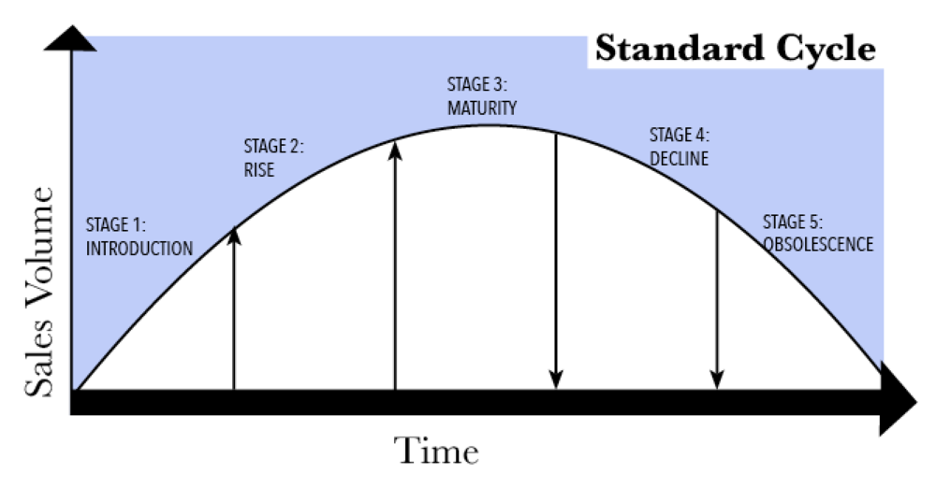The rise and fall of trendy items is nothing new, but the speed at which we discard trends has never been so fast. Have you ever bought a piece of clothing because it was trendy online and cheap only to find it ugly a week later? It seems harder than ever to be ahead of trends and up to date. Could this be because the fashion industry itself is changing?
What Makes a Trend?
Before the internet, trends were seen in magazines and movies. Models, Hollywood, and companies got to decide what was trendy, whether that be clothes, makeup, or even people and body types. Control over the production of trends produced longer trend cycles of about twenty to thirty years.
A fundamental part of understanding fashion, trend cycles can be broken up into five parts. The first is an introduction. Self-explanatory, the introduction refers to when a style first appears on the scene, not with everyday consumers, but from designers and on runways. The introduction leads to the second step of increase. This is when the style gains traction and you can find it offered by retailers; at this point it gets the label of a trend. After the increase is the peak, the third part of the cycle. The market is fully saturated and the trend is widely produced with seemingly everyone wearing it. But, with this saturation comes the fourth step, the decline, as consumers become bored and turned off by the popularity of the trend. Finally, there is obsolescence; the trend is dead. People see it as outdated and have moved on to the next trend.

In theory, this process should take a long time, but now trend cycles have shortened to a mere three months. That doesn’t just happen on its own, though; industries change over time, but this is abnormal. The two main contributors at the moment are none other than social media and fast fashion.
Fast Fashion and the Industry
Fast fashion can be defined as cheaper clothes produced at faster rates. The low rates and high output are inherently unethical. Many have already discussed the environmental impact fast fashion has, with its water waste and environmentally damaging materials, as well as the unethical working conditions and inhumane payment of workers. These criticisms are the most important of the industry, but they are not it’s only impact. Fast fashion is changing the fashion industry to promote overconsumption while shortening trend cycles.
Fast fashion work by recreating trends and producing them quickly and cheaply. Shein, one of the most popular fast fashion companies, is said to get an item from pre-production to release in as little as three days. The constant production means the market is quickly oversaturated with new trends; the high production in so little time means mass amounts of people purchase and wear the trend at the same time, ultimately making it go out of style quicker. Other companies like Zara, H&M, and Forever21 work the same way. Even if they don’t control what becomes trendy, they certainly control the trend cycle through influence over consumers. In 2020, Shein made $10 billion, a stark increase compared to the $4.5 billion they made the year prior.
Social Media’s Influence
The modern increase of ever-changing trends and fast fashion did not happen on its own. Perhaps equally as responsible are social media sites such as Tik Tok and Instagram. The trends used to be controlled by magazines and movies. Now, we have greater access and exposure to celebrities and media that there are no more filters for trends. The rise of social media gave increased access to constantly changing trends where fast fashion gave the ability for quick and constant consumption. Celebrities and online influencers post a style, which fast fashion companies like Shein replicate almost immediately. More people post the new trend which leads to more consumption until the online sphere is oversaturated with people posting the trend until people quickly lose interest. This condenses the introduction, rise, and peak of the cycle and ultimately decreases the amount of time an item is in trend. This means the time between a person purchasing and throwing away the trend is extremely low. With new trends on the rise all the time, overconsumption has never been a bigger issue.
Social media is no stranger to the promotion of overconsumption. On sites like Instagram and Tik Tok, the pressure for each post to feature new and different outfits is immense. Youtube and Tik Tok also host large amounts of haul videos; people buy new wardrobes and spend thousands of dollars on packages of Shein clothes to showcase to their audiences. In combination with trends, the pressure is severe. Buying whole new wardrobes every couple of months to adhere to the ever-changing trends is all but abnormal online. This content in combination with PR packages (products sent to celebrities and influencers that usually showcase products before release) and influencer marketing persuade the public to continuously buy new clothes. Now, people buy trends without thinking if they will continue to wear them after the trend goes out of style; this is harmful because the new speed of the trend cycles makes things go out of fashion quickly. Or, people buy trends specifically for online usage before trashing or returning them once people have moved on to the next trend. Tik Tok, a short form content app that hosts videos from 15 seconds to 3 minutes in length that are tailored to your tastes and recommended to you, has around 1 billion users as of now. Not only are these short trend cycles and social pressures of adhering to trends impacting those posting on social media, but those watching as well. For millions of people, it has become normal to buy a new trend and throw it out in three months or less.
What Can We Do?
Needless to say, the waste produced by consuming fast fashion and adhering to trend cycles is not beneficial to anyone besides the companies. A common term used recently is that of “there is no ethical consumption under capitalism” to describe that no single consumer can be completely free from the guilt of being unethical, but it is not their fault as there is no way to truly be an ethical consumer. While this may be true, many have used it to excuse blatant and unnecessary overconsumption under the guise that there is nothing we can do about it. Understandably, ethical consumption is not something that everyone has access to or can afford, even on a small scale. But, when we see large amounts of expensive haul videos from fast fashion companies excused by the idea that no one can be completely ethical, it does more harm than good.
As the average consumer, there are many things we do to make sure we escape the overconsumption of trend cycles and lead better lives. Within fashion, we can discover what we like. Instead of simply following trends as they come and go, if we analyze them critically we can dissect what we enjoy about them even once the trend has gone away. Personal taste in fashion is ultimately what defines your experience in the industry. Once you know what styles you like on yourself you can examine the rising trends more closely to see if you would genuinely want to wear them even if it wasn’t trending. This is the first major step to cutting your consumption.
Of course, the purchase of clothes is inevitable and is not always bad. There are many ways to ethically source new clothes, or at least clothes that are new to you. One of the most major ways is thrifting. Thrift and second-hand clothing stores are great ways to cut down on consumption and reuse clothing that others have discarded. This is especially helpful if you have determined your personal style already and the current market is oversaturated with items that you have no taste for. Upcycling is another way to reuse clothing to make it fit your current style without having to purchase anything new. Most importantly, the easiest way to be more ethical in your consumption is perhaps the most simple; consume less. There is no need to constantly throw out old clothes and replace them with new ones every few months. The less you purchase, the less you support unethical practices.
Of course, this is easier said than done, especially for lower-income people or those without access to thrift stores. But, ultimately, those who can do these things have a responsibility to the planet and those who live on it to engage critically with trends and consume responsibly.


